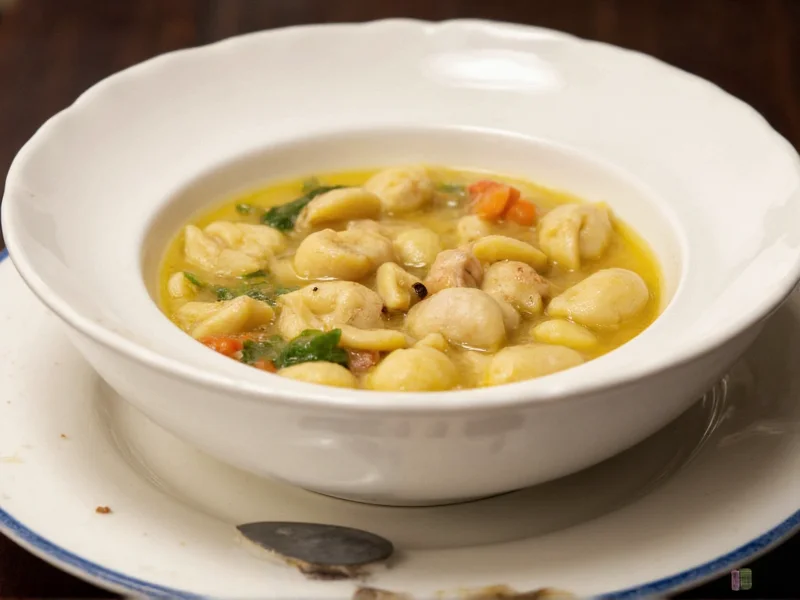The Essential Guide to Perfect Gnocchi Chicken Soup
Gnocchi chicken soup has become a staple in modern comfort food cuisine, blending Italian dumpling tradition with classic American soup preparation. Unlike traditional chicken noodle soup, this variation uses soft potato gnocchi that cook quickly and provide a satisfying, cloud-like texture. The dish works equally well as a weeknight dinner solution or an impressive meal for guests when elevated with fresh herbs and quality ingredients.
Why Gnocchi Transforms Chicken Soup
Potato gnocchi brings unique properties to chicken soup that pasta or noodles can't match. These delicate dumplings:
- Cook in just 2-3 minutes, preventing overcooking common with traditional noodles
- Absorb broth flavors while maintaining structural integrity
- Provide a lighter carbohydrate option compared to egg noodles
- Create a naturally thicker, more satisfying broth without flour roux
| Gnocchi Type | Cooking Time | Texture Result | Best For |
|---|---|---|---|
| Fresh refrigerated | 2-3 minutes | Pillowy, delicate | Weeknight meals |
| Dry shelf-stable | 5-7 minutes | Firmer, more resilient | Meal prep |
| Homemade potato | 2 minutes | Ultra-light, melt-in-mouth | Special occasions |
| Ricotta gnocchi | 3 minutes | Creamier, richer | Winter variations |
Building Flavor Foundations
Professional chefs emphasize layering flavors from the start. Begin with quality chicken broth - homemade provides superior depth, but low-sodium store-bought works well with enhancements. Sauté aromatics like onion, celery, and carrots in olive oil until translucent before adding broth. For easy gnocchi chicken soup recipe success, add fresh thyme and a Parmesan rind during simmering to develop complex umami notes without excessive salt.
Step-by-Step Preparation
Follow this method for homemade gnocchi chicken soup that consistently impresses:
- Prepare 6 cups quality chicken broth and bring to gentle simmer
- Sauté 1 diced onion, 2 chopped carrots, and 2 celery stalks in 2 tbsp olive oil until softened
- Add broth, 1 tsp thyme, and Parmesan rind; simmer 15 minutes
- Stir in 2 cups shredded cooked chicken and 1 (16oz) package gnocchi
- Cook gnocchi 2-3 minutes until they float to surface
- Remove Parmesan rind; stir in 1 cup fresh spinach and 2 tbsp lemon juice
- Season with salt, pepper, and red pepper flakes to taste
Expert Tips for Perfect Results
Avoid common pitfalls with these professional techniques:
- Don't overcook gnocchi - add them during the final minutes of preparation
- Use broth temperature - maintain gentle simmer, not rolling boil, to prevent gnocchi disintegration
- Add acid at the end - lemon juice or vinegar brightens flavors without breaking down ingredients
- Reserve some broth - if soup thickens too much during storage, thin with reserved broth
Variations for Every Preference
Customize your gnocchi chicken soup with vegetables using these adaptations:
- Creamy version: Stir in ½ cup heavy cream or coconut milk at the end
- Gluten free gnocchi chicken soup: Most potato gnocchi are naturally gluten-free (verify packaging)
- Extra vegetable boost: Add zucchini, kale, or peas during the last 5 minutes
- Spicy kick: Infuse broth with red pepper flakes or add harissa paste
Serving and Storage Guidance
For optimal gnocchi chicken soup storage tips, cool soup completely before refrigerating in airtight containers. The soup keeps well for 3-4 days, though gnocchi softens slightly over time. Reheat gently on stove with a splash of broth to restore texture. Freeze without gnocchi for best results, adding fresh gnocchi when reheating. Serve with crusty bread and a sprinkle of fresh parsley or basil for restaurant-worthy presentation.
Frequently Asked Questions
Can I use frozen gnocchi in chicken soup?
Yes, frozen gnocchi works well in chicken soup. Add them directly to simmering broth without thawing and cook 1-2 minutes longer than fresh gnocchi. The key is maintaining a gentle simmer rather than vigorous boil to prevent disintegration.
How do I prevent gnocchi from becoming mushy in soup?
Add gnocchi during the final 2-3 minutes of cooking, just until they float to the surface. Keep broth at a gentle simmer, not a rolling boil. For meal prep, cook gnocchi separately and add to reheated soup to maintain perfect texture.
What's the best substitute for potato gnocchi?
Ricotta gnocchi provides a creamier alternative that holds shape well in soup. For grain-free options, consider cauliflower gnocchi though it has different texture. Traditional pasta like ditalini or small shells work in a pinch but require adjusted cooking times.
Can I make gnocchi chicken soup in a slow cooker?
Yes, but add gnocchi during the last 15-20 minutes of cooking on low setting. Prepare broth and vegetables in slow cooker first, then stir in cooked chicken and gnocchi near the end to prevent overcooking. This quick gnocchi chicken soup method works best with refrigerated rather than dry gnocchi.
How can I make my gnocchi chicken soup healthier?
Boost nutrition in your healthy gnocchi chicken soup by increasing vegetable content with spinach, kale, or zucchini. Use low-sodium broth and control salt levels yourself. Opt for whole food ingredients rather than processed components. For lower carbohydrate content, reduce gnocchi quantity and increase vegetable volume proportionally.











 浙公网安备
33010002000092号
浙公网安备
33010002000092号 浙B2-20120091-4
浙B2-20120091-4